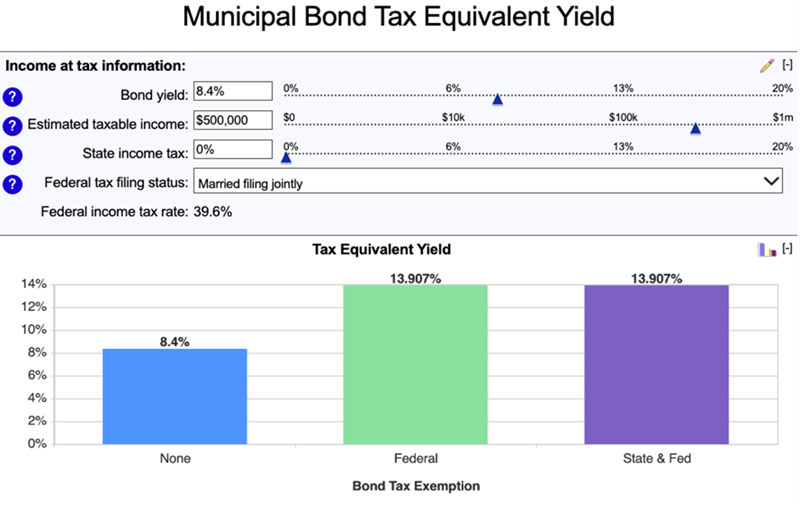The powers that be are playing a high-stakes game of “tariff roulette”—and I don’t know about you, but I don’t want to put my life savings on the table here!
But we’re not among the crowd bailing on stocks, either.
No way. We’re retirees (or aspiring retirees!), and we demand income. So instead, we’re going to look to “tariff-proof” (or “recession-proof,” if you think this trade war is sending us there) our portfolio. And we’re going to do it while cutting our tax bill, too.
Our timing is right here because the jump in 10-year Treasury rates we’ve seen since the “Liberation Day” tariff announcement has given us a window to secure one of my favorite tax-free 8.4% payers at a “double discount.”
That’s right: We’re getting a deal on both the fund’s portfolio, which has moved lower as rates jumped, and on the fund itself, which trades at a rare 10% discount to the net asset value (NAV or the value of its assets).
Translation: We can buy this stout fund’s portfolio for 90 cents on the dollar!
Tariff Drama Gives Us an Opportunity for 8.4% Tax-Free Dividends
As the tariff-driven volatility continues, we’re looking at the ultimate domestic income play: municipal, or “muni,” bonds, issued by local and state governments to fund infrastructure projects: think roads, bridges, schools and hospitals.
Many investors sidestep munis, partly because getting in on these bonds is tough for individual investors—especially if we want to get in on the best new issues. That’s why we’re going to buy through a muni-focused closed-end fund (CEF)—the Nuveen Quality Municipal Income Fund (NYSE:NAD), a holding of my Contrarian Income Report service. As I write, this one is paying a rich 8.4% dividend.
What’s more, the income from muni bonds is tax-free for most Americans. Many munis are also tax-exempt at the state level.
It’s hard to underestimate what that tax exemption does to a muni’s “headline” yield. Consider the 8.4% payout on NAD, for example: If you’re in the top bracket, you’d need a 13.9% payout on a taxable asset, like a stock, to match it, according to Bankrate’s taxable-equivalent yield calculator!

Source: Bankrate.com
Safety? As I write this, the mean default rate on munis cumulatively over the last decade stands at just 0.1%, according to December numbers from JPMorgan Private Bank. And let’s not forget that we’ve got the quiet backing of Jay Powell here.
As I’ve written before, Powell (very quietly) pumped liquidity into the banking system when a few shaky institutions crumbled in early 2023. So we can be certain he’d ride to the rescue if any cracks were to show up in the muni market, especially as these bonds are widely held by pension funds, insurers and retirees.
Here’s where our opportunity comes in because munis tend to move in opposition to the yield on the 10-year Treasury note—so they’ve pulled back as so-called “long” rates jumped in the days following the “Liberation Day” tariff announcement.
The muni-bond benchmark iShares National Muni Bond ETF (NYSE:MUB), for example, is down about 1%—a big move for these normally placid income plays:
Muni Dip Brings Our Opportunity

But we’re not going with MUB here, The fund’s 3.2% dividend just doesn’t do it for us—tax-free or no.
Plus, when we buy munis (and any other asset, for that matter!), we demand a discount. And MUB, as an ETF, rarely offers one since these funds issue shares to ensure their market price and net asset value (NAV, or the value of their underlying portfolios) align.
Instead, we look to CEFs, which have a fixed share count. That allows their market prices to deviate from NAV—and they often trade at a discount. What’s more, we get the services of a pro fund manager, a necessity in the tight-knit muni world, where personal connections matter.
That’s where the Nuveen Quality Municipal Income Fund (NAD) re-enters the picture. NAD’s issuer, Nuveen, manages $441 billion worth of bonds and is a big buyer. When municipalities issue bonds—or think about it—they call big whale Nuveen. The muni giant throws its purse around to secure the best deals for its investors.
NAD’s portfolio reflects that: It includes 1,193 bonds with an average leverage adjusted duration of 13.5 years. Its average coupon is about 4.4%, and, as I just touched on, Nuveen deftly enhances returns with leverage, to the tune of 40.9% of the portfolio currently.
That’s a more-than-acceptable level, given the stability of the fund’s holdings. And I expect a recession later this year to pull down interest rates—and NAD’s borrowing costs—while driving up investor demand for income plays like NAD.
Over the long haul—the best timeframe in which to hold munis—NAD has more than delivered, with a 231% total return since inception in 1999:
A Long-Term Wealth (and Income) Generator
As you can see on the right side of that chart, muni funds like NAD were on fire in 2024, but munis have since pulled back with the rise in long rates. Plus, we’ve got that 10% discount to NAV I mentioned earlier, so we can pick up its portfolio of munis for less than it’s worth. Let’s take that opportunity.
Disclosure: Brett Owens and Michael Foster are contrarian income investors who look for undervalued stocks/funds across the U.S. markets. Click here to learn how to profit from their strategies in the latest report, "7 Great Dividend Growth Stocks for a Secure Retirement."

